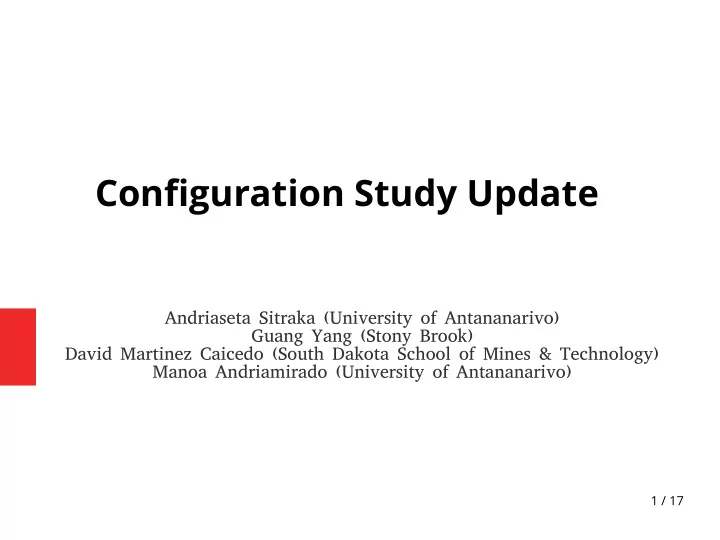

Confjguration Study Update Andriaseta Sitraka (University of Antananarivo) Guang Yang (Stony Brook) David Martinez Caicedo (South Dakota School of Mines & Technology) Manoa Andriamirado (University of Antananarivo) 1 / 17
Initial Steps ● Simulation – DUNENDGGD GENIE EDEPSIM → → ● Work with plain root fjles – Lepton information – Hadron information – Neutron information ● Analysis run locally 2 / 17
3 / 17 Slide from Guang Yang (Stony Brook): https://indico.fnal.gov/event/19292/contribution/1/material/slides/0.pdf
Muon Effjciency Muon coverage Geometry 1 Muon coverage Geometry 2 Muon coverage Geometry 3 ● Efficiency = Energy deposit within [3DST] and [3DST + TPC] / All Energy deposits ● CC events: ● Geometry 1: 75.3291% (2861) ● Geometry 2: 74.5059% (26165) ● Geometry 3: 75.0115% (32555) 4 / 17
Pion Effjciency Pion coverage Geometry 2 Pion coverage Geometry 1 Pion coverage Geometry 3 ● Efficiency = Energy deposit within [3DST] and [3DST + TPC] / All Energy deposits ● CC events: ● Geometry 1: 75.3291% (2861) ● Geometry 2: 74.5059% (26165) ● Geometry 3: 75.0115% (32555) 5 / 17
Hadronic containment Effjciency Hadronic Energy deposit ratio Geometry 1 Hadronic Energy deposit ratio Geometry 2 Hadronic Energy deposit ratio Geometry 3 ● Ratio = Energy deposit within 3DST + ECAL / all deposits within 3DST + all ECAL volume ● No leaked energy 6 / 17
Next steps ● Play with difgerent geometries (Guang Yang, Jairo R.) ● Add neutron information (on going) 7 / 17
Backup slides 8 / 17
Geometry 1 (Muon) 9 / 17
Geometry 1 (Charged Pion) 10 / 17
Geometry 1 (hadron) 11 / 17
Geometry 2 (Muon) 12 / 17
Geometry 2 (Charged pion) 13 / 17
Geometry 2 (hadron) 14 / 17
Geometry 3 (Muon) 15 / 17
Geometry 3 (Charged pion) 16 / 17
Geometry 3 (hadron) 17 / 17
Recommend
More recommend